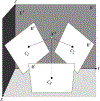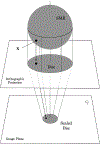An invisible-stylus-based coordinate measurement system via scaled orthographic projection
- PMID: 39440143
- PMCID: PMC11494961
- DOI: 10.1016/j.precisioneng.2018.12.002
An invisible-stylus-based coordinate measurement system via scaled orthographic projection
Abstract
We present on a simple yet effective method for creating an invisible stylus from which a non-contact 3-D coordinated measuring system (the PiCMS) is realized. This invisible stylus dubbed a Pixel Probe is created through the orthographic projection of a spherical mounted reflector (SMR) through a trifocal camera system. Through this, a single point in space that is linked to a laser tracker world frame is mapped to a unique set of pixel coordinates in the trifocal camera creating the Pixel Probe. The system is constructed through the union of a Pixel Probe, a laser tracker, and calibrated stage, and does not require contact to obtain a measurement. In the current configuration, system resolution and accuracy better than is demonstrated on objects in the meso/micro scale that are well below the range of a laser tracker alone. A simple single-point coincidence condition allows the user to specify a measurement coordinate by pointing-and-clicking in the images captured by the Pixel Probe. We describe this system using multi-view geometry vision theory and present proof of concept measurement examples of 2-D and 3-D objects.
Keywords: Coordinate measuring machine; Laser tracker; Machine vision; Metrology; Non-contact; Probe; Spherical-mounted reflector.
Figures


















Similar articles
-
Freezing Time: Dynamic Laser Tracker Measurements With the Pixel Probe Using Temporal Aliasing.J CMSC. 2016;11(2):5-10. J CMSC. 2016. PMID: 39484205 Free PMC article.
-
A contact probe based on multi-focus spectral confocal method for in-site measurement of form and position errors of complex surface workpieces.Rev Sci Instrum. 2025 Mar 1;96(3):035005. doi: 10.1063/5.0231304. Rev Sci Instrum. 2025. PMID: 40105457
-
The Impact of Probe Angle and Swivel Length on Contact Point Identification in Coordinate Measuring Machine Measurements: A Case Study.Sensors (Basel). 2025 Mar 23;25(7):2008. doi: 10.3390/s25072008. Sensors (Basel). 2025. PMID: 40218522 Free PMC article.
-
Extrinsic parameters calibration of multi-camera with non-overlapping fields of view using laser scanning.Opt Express. 2019 Jun 10;27(12):16719-16737. doi: 10.1364/OE.27.016719. Opt Express. 2019. PMID: 31252894
-
Improving Measurement Accuracy of Deep Hole Measurement Instruments through Perspective Transformation.Sensors (Basel). 2024 May 16;24(10):3158. doi: 10.3390/s24103158. Sensors (Basel). 2024. PMID: 38794012 Free PMC article.
References
-
- Hocken JR, Pereira PH. Coordinate measuring machines and systems. second ed.CRC Press; 2016.
-
- Hocken RJ, Borchardt BR. On characterizing measuring machine geometry. NBSIR; 1979:79–1752.
-
- Stoup JR, Doiron TD. Accuracy and versatility of the NIST M48 coordinate measuring machine. Proc SPIE 2001;4401:136–46.
-
- Cuypers W, Gestel NV, Voet A, Kruth JP, Mingneau J, Bleys P. Optical measurement techniques for mobile and large-scale dimensional metrology. Optic Laser Eng 2009;47:292–300.
-
- Bqersad J, Poozesh P, Niezrecki C, Avitabile P. Photogrammetry and optical methods in structural dynamic-A review. Mech Syst Signal Process 2017;86:17–34.
Grants and funding
LinkOut - more resources
Full Text Sources
